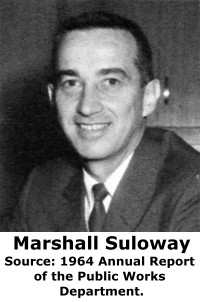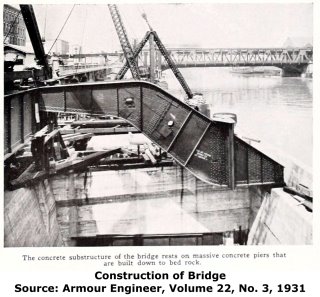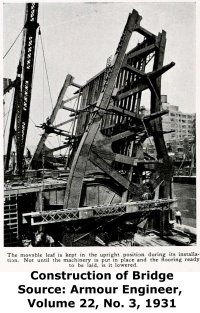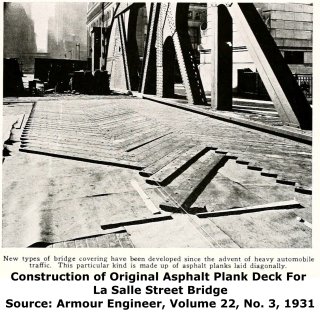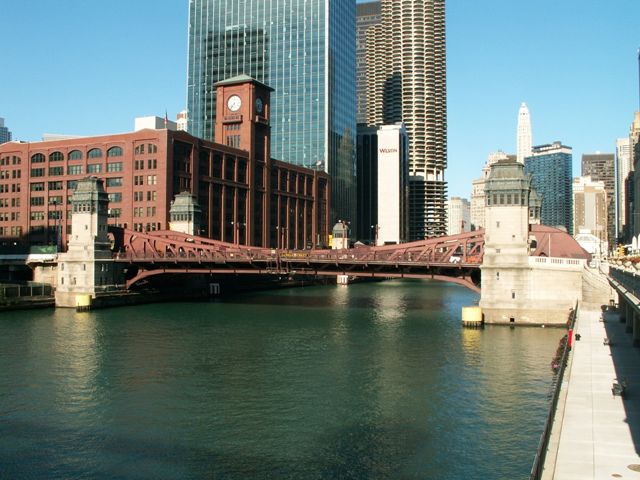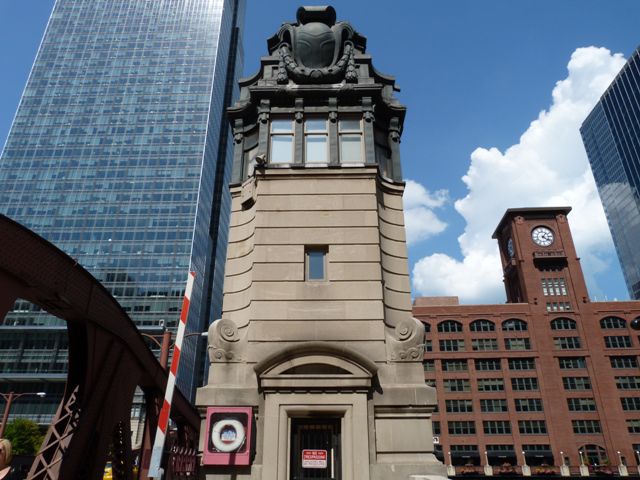We Recommend:
Bach Steel - Experts at historic truss bridge restoration.
BridgeHunter.com Phase 1 is released to the public! - Visit Now
La Salle Street Bridge
Marshall Suloway Bridge
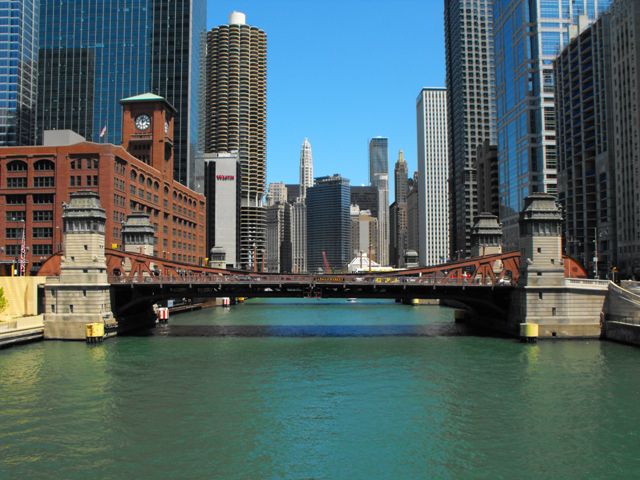
Primary Photographer(s): Nathan Holth
Bridge Documented: August 12, 2006 - October 14, 2021
Chicago: Cook County, Illinois: United States
Metal Rivet-Connected Pratt Pony Truss, Movable: Double Leaf Bascule (Fixed Trunnion) and Approach Spans: Metal Stringer (Multi-Beam), Fixed
1928 By Builder/Contractor: Strobel Steel Construction Company of Chicago, Illinois and Engineer/Design: City of Chicago
Not Available or Not Applicable
242.0 Feet (73.8 Meters)
347.0 Feet (105.8 Meters)
56 Feet (17.07 Meters)
1 Main Span(s) and 3 Approach Span(s)
16603226800

View Information About HSR Ratings
Bridge Documentation
Additional Information: Although it takes place in Louisiana in a city modeled after New Orleans, the game Mafia III features a bridge that was inspired strongly by this bridge to the point where the four bridgetender towers, truss design, and paint color are replicated quite accurately. In-game, it is the southernmost bridge between Tickfaw Harbor and the French Ward.
View Archived National Bridge Inventory Report - Has Additional Details and Evaluation
View Historic American Engineering Record (HAER) Documentation For This Bridge
HAER Drawings, PDF - HAER Data Pages, PDF
View A Short Biography of Charles Louis Strobel
View A Draft West Loop Historic District Nomination Form That Includes This Bridge
About This Bridge
This bridge's trusses are quite similar to the nearby Clark Street Bridge. It is somewhat similar to Franklin Street. However, this bridge shares the common trait with La Salle in that the taller ends of the bridges feature more round-shaped ends than Franklin Street. The Grand Avenue Bridge is an example of a bridge from the older "second generation" of bascule bridges that utilizes this same general design (pony truss), but has a more clunky appearance with less curving of the top chord. The La Salle Street Bridge retains its original ornate railings, a trait it shares with the Franklin Street Bridge, but not the Clark Street Bridge. Clark, Franklin and La Salle Street Bridges are perhaps the three most aesthetically pleasing examples of the pony truss bascule bridge in Chicago. The unusual, eye-catching shape that the trusses form is made truly beautiful with the graceful curve of the top chord, and the bridge tender buildings for these bridges are among the more ornate and well-preserved examples in Chicago.

From south to north the La Salle Street Bridge has a 1.58% grade. The La Salle Street Bridge is one of only a few bascule bridges in Chicago constructed with four bridge tender house buildings. Generally, there was not a need for more than two bridge tender houses. The use of four buildings was likely an aesthetic consideration. Given that only a few Chicago bridges feature four bridge tender houses, and that constructing two extra houses would have cost a fair amount of money, it is evident that the La Salle Street Bridge was considered an important crossing. It may have something to do with the fact that La Salle Street south of the bridge is the financial center of Chicago, with the Chicago Board of Trade building in the distance, and other landmarks like the Federal Reserve Bank of Chicago located on this street. The La Salle Street Bridge's bridge tender houses are also one of the most ornate of Chicago's bridges. The mansard roof of the buildings contains a decoration that includes the inverted Y which is Chicago's Municipal Device, a symbol of the city.
The La Salle Street Bridge celebrates its 85th Anniversary on December 20, 2013. Jim Phillpis of www.chicagoloopbridges.com produced this news release discussing the event and its significance.

The official name for this bridge, Marshall Suloway Bridge, was dedicated in 1999 to honor the Commissioner of Public Works under Mayor Richard J. Daley, according to the plaque on the bridge. Suloway also served as Chicago's Chief Engineer for a time. The bridge was built in 1928, with Strobel Steel Company building the superstructure of the bridge. The substructure of the bridge was built by the Central Dredging Company. Kelly-Atkinson Construction Company built the bridge-tender houses, and Norwood-Noonan Company installed the electrical equipment.
Planned Rehabilitation
The Chicago Department of Transportation is planning a major rehabilitation of this iconic historic bridge. They currently anticipate design approval for March 2015. Construction would occur some time after that. The proposed scope of work would include the following: Replacement of deck including deck stringers, and installation of a concrete filled grate deck for the roadway and fiberglass for the sidewalks. Replacement of the truss lateral bracing. General repairs to the trusses and floorbeams. General repairs to the substructure. Repair of the electrical system and mechanical components as needed. The bridge tender houses will be rehabilitated. Rehabilitation of architectural elements of the bridge tender houses will include stonework, windows, doors, roofing, etc.
Strobel Steel Construction Company
Strobel Steel Construction company built the superstructures for a number of Chicago bridges including the La Salle Street Bridge. A 1914 publication called Builders of Our Nation, Men of Nineteen-Thirteen offered the following discussion of Charles Louis Strobel who formed the company.
Strobel, Charles Louis, civil engineer; born in Cincinnati, O., Oct. 6, 1852; son of Carl Strobel and Ida (Merker) Strobel. He was educated in the Cincinnati public schools until seventeen, then in the Royal Technical University at Stuttgart, Germany, graduating as C.E. He was assistant engineer of the Cincinnati Southern Railway at Cincinnati, 1874-78; assistant to president and engineer at Pittsburgh of Keystone Bridge Co., 1878. He removed to Chicago in October, 1885, retaining connection, as consulting engineer, with the Keystone Bridge Company, and also acting as consulting engineer to Carnegie, Phipps & Company, Limited, until 1893, and other firms. In 1893 he went into business for himself as consulting and contracting engineer for the building of bridges and other structures in steel. In May. 1905, he incorporated his business under the firm name of Strobel Steel Construction Company. He designed and built many important bridges and other structures. He was editor of the Handbook of Useful Information for Engineers and Architects, first published in 1881 for Carnegie, Phipps & Company, Limited. He is a republican in politics. Mr. Strobel is a member of the Institution of Civil Engineers, the American Society of Civil Engineers, and of the Western Society of Engineers. He is a member of the Commercial, Chicago, Chicago Golf. Saddle and Cycle, and University Clubs. He married in Chicago, Ill., Dec. 2, 1890, Henrietta Baxter, who died March, 1905, and has two children: Charles Louis, Jr., born in 1891, and Marion, born in 1805. Residence: 846 Lincoln Parkway, Chicago. Office address: 1744-48 Monadnock Block, Chicago, Ill. Married Mary Wilkins, July J0, 19l0, at Chicago, Ill.
Above: This photo shows the construction of the substructure for the bridge. Visible is the counterweight pit and the completed trunnion girder with its unique shape. Typical of trunnion girders, the design allows for the trunnion and the bascule leaf to be held in place, while dealing with a counterweight pit directly beneath where the trunnion is located. This uniquely shaped design employed by the city was a design that did not conflict with patents held by Joseph Strauss, unlike earlier designs the city used, which resulted in a successful lawsuit by Strauss against the city.
Above: A photo showing the construction of one of the bascule leaves.
Above: Chicago's movable bridges did not always have the steel grid deck that is familiar to those found today. Here, the La Salle Street Bridge is seen having its original deck installed, which consist of asphalt planks laid in a diagonal fashion.
Above: A historical photo showing the newly completed bridge.
|
Main Plaque WM HALE THOMPSONMAYOR
CHICAGO PLAN COMMISSION.
CHICAGO CHAPTER OF AMERICAN INSTITUTE OF ARCHITECTS, ILLINOIS SOCIETY OF ARCHITECTS. CHICAGO ART COMMISSION.
1928 |
Dedication Plaque MARSHALL SULOWAY, P. E.CHIEF ENGINEER 1967 - 1973 COMMISSIONER 1973 - 1979 CHICAGO DEPARTMENT OF PUBLIC WORKS MARSHALL SULOWAY BRIDGE IN RECOGNITION OF OVER FIFTY YEARS OF ENGINEERING ACHIEVEMENT TO MAKE THE CITY OF CHICAGO A BETTER PLACE TO LIVE
|
![]()
Historic Bridges of Chicago and Cook County


Chicago and Cook County are home to one of the largest collections of historic bridges in the country, and no other city in the world has more movable bridges. HistoricBridges.org is proud to offer the most extensive coverage of historic Chicago bridges on the Internet.
General Chicago / Cook County Bridge Resources
Chicago's Bridges - By Nathan Holth, author of HistoricBridges.org, this book provides a discussion of the history of Chicago's movable bridges, and includes a virtual tour discussing all movable bridges remaining in Chicago today. Despite this broad coverage, the book is presented in a compact format that is easy to take with you and carry around for reference on a visit to Chicago. The book includes dozens of full color photos. Only $9.95 U.S! ($11.95 Canadian). Order on Amazon.
Chicago River Bridges - By Patrick T. McBriarty, this is a great companion to Holth's book shown above. This much larger book offers an extremely in-depth exploration of Chicago's movable highway bridges, including many crossings that have not existed for many years. Order Now Direct From The Publisher! or order on Amazon.
View Historic American Engineering Record (HAER) Overview of Chicago Bascule Bridges (HAER Data Pages, PDF)
Chicago Loop Bridges - Chicago Loop Bridges is another website on the Internet that is a great companion to the HistoricBridges.org coverage of the 18 movable bridges within the Chicago Loop. This website includes additional information such as connections to popular culture, overview discussions and essays about Chicago's movable bridges, additional videos, and current news and events relating to the bridges.
Additional Online Articles and Resources - This page is a large gathering of interesting articles and resources that HistoricBridges.org has uncovered during research, but which were not specific to a particular bridge listing.
This bridge is tagged with the following special condition(s): Unorganized Photos
![]()
Photo Galleries and Videos: La Salle Street Bridge
Structure Overview
Original / Full Size PhotosA collection of overview photos that show the bridge as a whole and general areas of the bridge. This gallery offers photos in the highest available resolution and file size in a touch-friendly popup viewer.
Alternatively, Browse Without Using Viewer
![]()
Structure Details
Original / Full Size PhotosA collection of detail photos that document the parts, construction, and condition of the bridge. This gallery offers photos in the highest available resolution and file size in a touch-friendly popup viewer.
Alternatively, Browse Without Using Viewer
![]()
Structure Overview
Mobile Optimized PhotosA collection of overview photos that show the bridge as a whole and general areas of the bridge. This gallery features data-friendly, fast-loading photos in a touch-friendly popup viewer.
Alternatively, Browse Without Using Viewer
![]()
Structure Details
Mobile Optimized PhotosA collection of detail photos that document the parts, construction, and condition of the bridge. This gallery features data-friendly, fast-loading photos in a touch-friendly popup viewer.
Alternatively, Browse Without Using Viewer
![]()
Additional Unorganized Photos
Original / Full Size PhotosA supplemental collection of photos that are from additional visit(s) to the bridge and have not been organized or captioned. This gallery offers photos in the highest available resolution and file size in a touch-friendly popup viewer.
Alternatively, Browse Without Using Viewer
![]()
Additional Unorganized Photos
Mobile Optimized PhotosA supplemental collection of photos that are from additional visit(s) to the bridge and have not been organized or captioned. This gallery features data-friendly, fast-loading photos in a touch-friendly popup viewer.
Alternatively, Browse Without Using Viewer
![]()
Raising Bridge, View Beside
Full Motion VideoNote: The downloadable high quality version of this video (available on the video page) is well worth the download since it offers excellent 1080 HD detail and is vastly more impressive than the compressed streaming video. Streaming video of the bridge. Also includes a higher quality downloadable video for greater clarity or offline viewing.
![]()
Lowering Leaf, Oblique
Full Motion VideoTaken June 2011 Streaming video of the bridge. Also includes a higher quality downloadable video for greater clarity or offline viewing.
![]()
Lowering The Bridge
Full Motion VideoStreaming video of the bridge. Also includes a higher quality downloadable video for greater clarity or offline viewing.
![]()
Maps and Links: La Salle Street Bridge
Coordinates (Latitude, Longitude):
Search For Additional Bridge Listings:
Bridgehunter.com: View listed bridges within 0.5 miles (0.8 kilometers) of this bridge.
Bridgehunter.com: View listed bridges within 10 miles (16 kilometers) of this bridge.
Additional Maps:
Google Streetview (If Available)
GeoHack (Additional Links and Coordinates)
Apple Maps (Via DuckDuckGo Search)
Apple Maps (Apple devices only)
Android: Open Location In Your Map or GPS App
Flickr Gallery (Find Nearby Photos)
Wikimedia Commons (Find Nearby Photos)
Directions Via Sygic For Android
Directions Via Sygic For iOS and Android Dolphin Browser
USGS National Map (United States Only)
Historical USGS Topo Maps (United States Only)
Historic Aerials (United States Only)
CalTopo Maps (United States Only)


